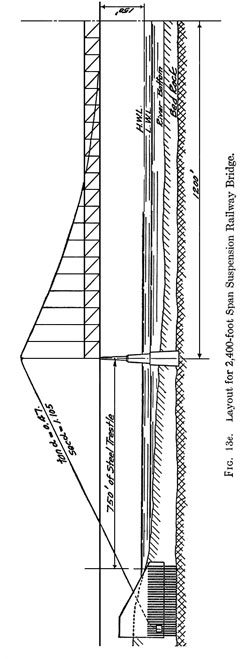| 98 | ECONOMICS OF BRIDGEWORK | Chapter XIII |
|
the costs of the anchorages of the suspension bridges and to a much smaller |
|
extent those of the anchor piers of the cantilever structures. The effect of this change on the cost curves is shown in Fig. 13f. From it there will be observed that the span-length for equal cost has been brought down to about 2,570 feet, showing that the change made in the bed-rock profile has effected comparatively little variation in this span-length. The result of the preceding calculations differs so fundamentally from that of Dr. Steinman that the author found it necessary to study carefully in detail the doctor's various assumptions and estimates, so as to discover the reason or reasons for the great difference — amounting to over one thousand feet. The following variations between his data and estimates as compared with those of the author were found: First. In his cantilever bridges Dr. Steinman makes the ratio of length of suspended span to that of main opening vary from 0.5 for 1,000-foot openings to 0.4 for 2,000-foot openings, while the author two decades ago showed the economic ratio to be 0.375; and, as previously mentioned, he (Dr. Steinman) makes the length of the anchor arm 0.4 of the main opening instead of about one-half of that amount. Second. Dr. Steinman's bridges carry both railway and highway live loads, while the author's are for railway traffic only. |
|
Third. Dr. Steinman's suspension bridges have side spans supported by the backstays, while in the author's layouts these spans are replaced |
